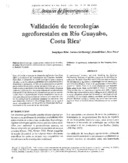| dc.description.abstract | Entre el CATIE, el Instituto de Desarrollo Agrario de Costa Rica (IDA) y productores del Asentamiento Río Guayabo, Turrialba, Costa Rica, se desarrolló un estudio participativo para evaluar la introducción de tecnologías agroforestales para conservar suelos y diversificar la producción. El 70 por ciento de los productores que participaron dentro del proyecto querían introducir Citrus sp. en sus cafetales o campos hortícolas como linderos entre parcelas, líneas en contorno o mini-parcelas. Tres meses después del establecimiento, hubo un 100 por ciento de sobrevivencia. Establecer capacidades, comunicación abierta y disposición para aceptar compromisos fueron factores que determinaron el éxito del proyecto para todos los actores. Se concluyó que la solidaridad triangular fue una buena base para desarrollar el proyecto. Sin embargo, todavía no se logró el mayor sinergísmo entre los tres actores. La mayor parte de la comunicación se dio entre dos de los tres actores. A participatory research approach, involving the Agrarian Development Institute of Costa Rica, farmers of the Rio Guayabo settlement, Turrialba, Costa Rica and CATIE, was used to evaluate the introduction of agroforestry technologies for soil conservation and farm diversification. Most of the participating farmers (70 percent) wanted to include Citrus sp. in coffee plantations and vegetable fields, using border lines, contour lines on slopes or micro-plots. Three months after tree planting, tree survival was 100 percent. Capacity building, open communication and a willingness of all collaborators to accept obligations determined the success of this project. It was concluded that the Triangle Solidarity provided a good base for the project. However, synergism between the actors could have been improved. Most communication was only between two of the three actors. | es_ES |


